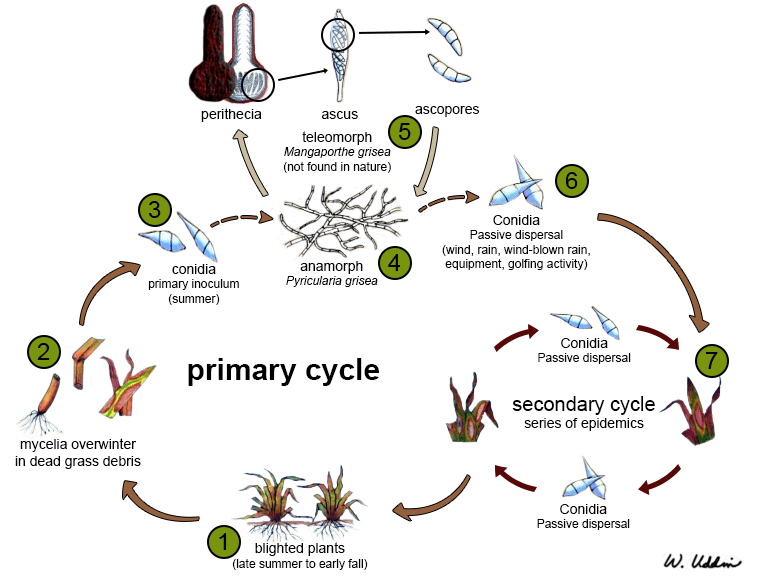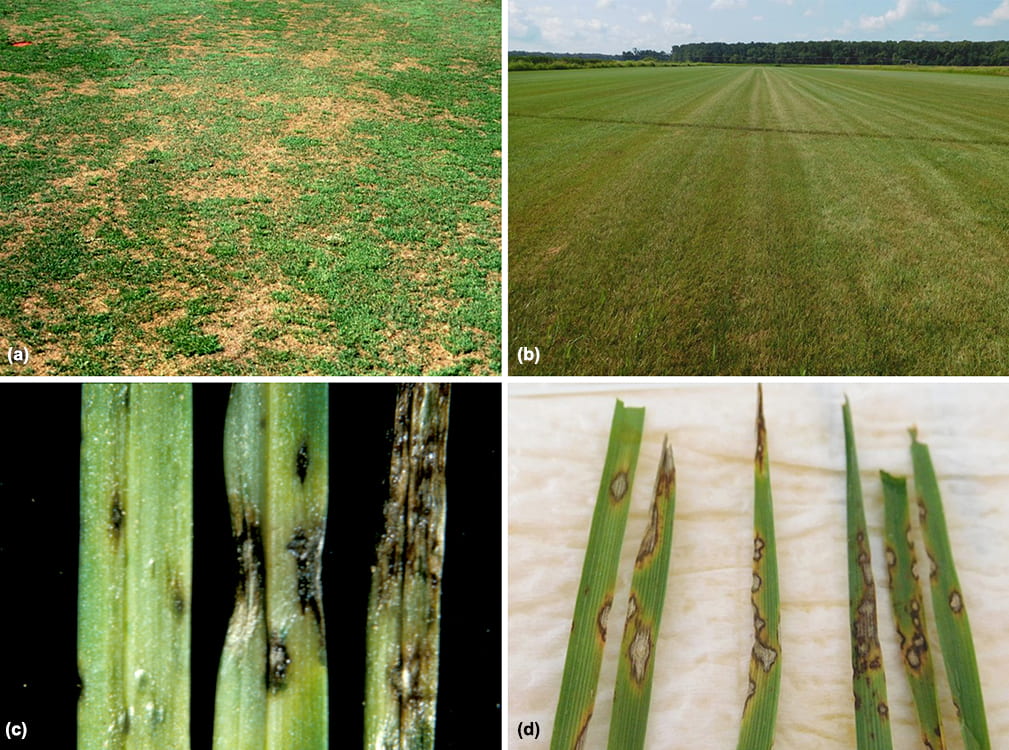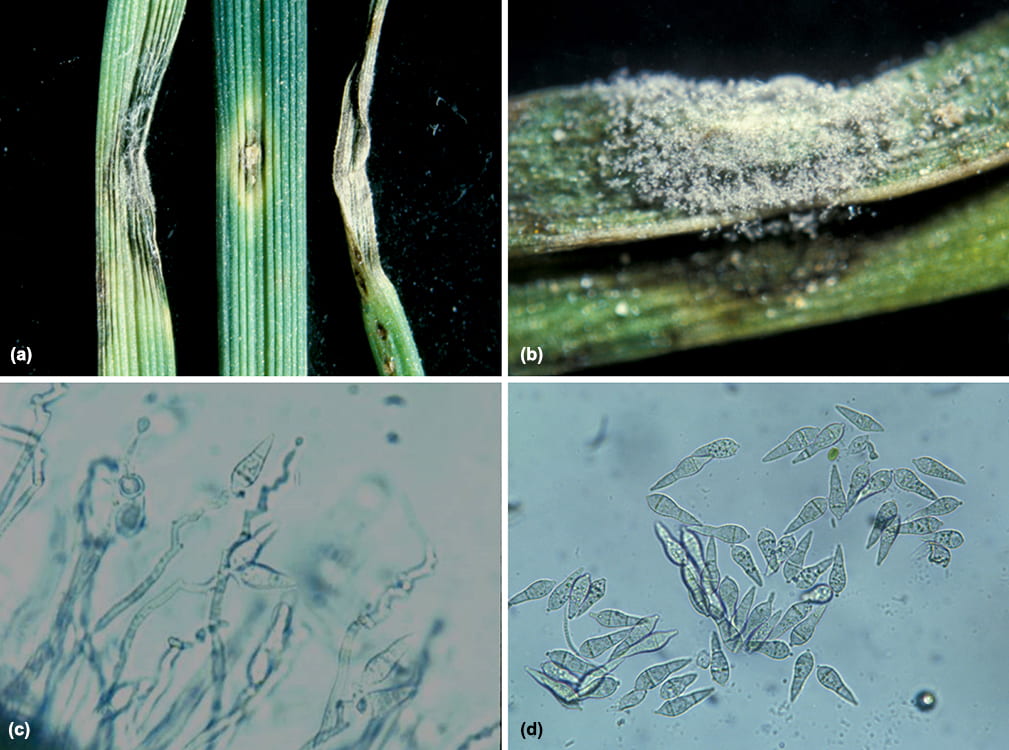Gray leaf spot is a destructive disease that primarily affects Stenotaphrum secundatum but has also been observed in other turfgrass species. While it has been reported on Cynodon and Paspalum spp., they are not considered primary hosts in the field. The disease is commonly known as gray leaf spot in North America and other regions, and it is also referred to as “blast” disease in forage grasses. Blast disease, caused by a closely related pathogen, affects rice, wheat, and finger millet among other cereal grains.
Credit: PACE Turf
Causal agents
Pyricularia oryzae fungus
Primary Hosts
Originally a disease of Stenotaphrum secundatum (St. Augustinegrass). It has become very destructive to Lolium perenne (perennial ryegrass) and Festuca arundinaceae (tall fescue) as well.
Disease Cycle
The gray leaf spot pathogen, Pyricularia oryzae, survives unfavorable conditions as dormant mycelium in infected leaves and plant debris. When the environment becomes suitable for its growth, the fungus produces conidiophores on necrotic tissue. These conidiophores generate and release conidia, which can be dispersed by wind, water, machinery, and animals. Conidia are produced abundantly in warm and humid conditions. Germination and infection of host tissue occur when the relative humidity is high and the leaf surface is moist. However, excessive leaf wetness can inhibit spore production. Ideal conditions for spore production and subsequent infection involve alternating wet and dry cycles over several days.

Credit: Wakar Uddin/Penn State University; Accessible Version (PDF)
Epidemiology
Gray leaf spot is most severe in warm and humid weather, with optimal temperatures ranging from 28 to 32°C (82 to 90°F). It commonly affects Lolium spp. during the summer months in the transition zone through the mid-Atlantic region. Outbreaks can last until October in the eastern United States and are active from late spring to early summer in the southern United States during overseeding. Newly established plantings are more susceptible, especially with moderate to high nitrogen fertility.
Factors contributing to disease development include:
- mowing height
- temperature
- leaf wetness
- herbicides
- drought
A predictive model based on temperature and leaf wetness is available for management.
Symptoms
Symptoms in Lolium spp. and Festuca arundinacea include small, water-soaked lesions that turn necrotic, varying in color and shape. Lesions may coalesce, blighting the leaf blades and forming irregular shapes. Infected patches can rapidly expand, resembling symptoms of brown patch. In severe cases, the entire turf may die. Festuca arundinacea generally recovers more rapidly than Lolium spp. when conditions are no longer favorable for disease development.
Symptoms of gray leaf spot in warm-season turfgrasses include dark, water-soaked lesions on leaves and stems that enlarge into round to diamond-shaped spots. The spots often occur along the leaf edges or midrib and may extend across the entire leaf. They have tan to gray centers with distinct reddish-brown borders.

Credit: Peter Dernoeden/University of Maryland
Signs
In both cool- and warm-season turfgrasses during warm and humid weather, the spots may be covered in grayish, felty masses of conidia. Individual conidia are borne on gray-to-olive conidiophores and are hyaline, pyriform in shape with two septations. Although perithecia have been produced in mating studies, the sexual stage of the pathogen has not been observed in nature.

Credit: Peter Dernoeden/University of Maryland and John Kaminski
Management
Managing gray leaf spot in turfgrass requires a combination of cultural and chemical approaches. To minimize the impact of the disease, it is important to implement cultural practices that reduce stress on the turf. This includes avoiding prolonged leaf wetness, excessive nitrogen application, soil compaction, and stress caused by plant growth regulators or herbicides. Deep and infrequent watering is recommended to prevent drought stress. Delaying overseeding in cooler weather can help reduce disease severity. While the impact of clippings removal is limited, it may be beneficial in low disease severity situations. Preventive fungicide applications are recommended in situations where the disease is chronic.
Cultural
To manage gray leaf spot, it is important to implement practices that minimize stress on the turf. This includes avoiding the following:
- extended periods of leaf wetness
- excessive nitrogen application
- soil compaction
- stress induced by plant growth regulators or herbicides
Delay overseeding in cooler autumn weather to reduce disease severity. While clippings removal has limited impact, it may be beneficial if disease severity is low.
Chemical
Fungicides can be effective in controlling gray leaf spot, especially for juvenile turfgrass during sod growth, or problematic areas. Preventive fungicide applications are recommended in chronic disease situations. Be aware of fungicide resistance and follow appropriate resistance management strategies, as some isolates of P. oryzae have shown resistance to fungicides within the QoI fungicide class. Where resistance isn’t an issue, the QoI fungicides work well. Additional fungicides include DMIs, thiophanate-methyl and combinations of these fungicides with chlorothalonil.
